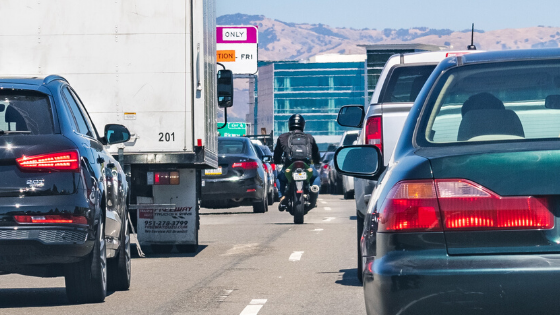If you’re a motorcyclist, you may already be familiar with the term lane splitting, which refers to a lane sharing maneuver. Only two states have legislation that allows motorcyclists to engage in lane sharing, which are California and Utah. Lane splitting is legal in California, and lane filtering is legal in Utah.
Continue reading to learn more about lane splitting and filtering to help you stay safe on the road.
Lane Filtering
Utah’s government passed a law known as House Bill 149 in 2019 that allows motorcyclists to lane filter. Lane filtering allows riders to filter between two lanes of stopped vehicles on roads with less than a 45 mph speed limit. They can’t move faster than 15 mph while filtering, and they must proceed with extra caution.
Unlike lane splitting, lane filtering allows a motorcyclist to trickle down between rows of stopped or slow-moving vehicles. They usually practice this maneuver at stoplights because it allows them to navigate toward the front of the line; this allows them to take off smoothly without being caught in between two vehicles.
The new law aims to reduce road congestion and make motorcycle riding safer. Lane filtering is prohibited when there’s ongoing traffic, between rows of parked cars, or by a curb.
If you’re not a motorcyclist, you may not understand why lane filtering is important. It’s easy to assume motorcycle riders are just trying to cut in line, but the law has nothing to do with giving them special advantages. The main reason why this maneuver is necessary is because it reduces the likelihood of motorcycles coming into contact with cars.
From 2011-2017, approximately 1,300 motorcyclists were rear-ended in Utah alone, resulting in injuries and fatalities, according to the Utah Department of Public Safety. Filtering protects motorcyclists from being rear-ended, and it ensures every car driver is aware of them.
Lane Splitting
Lane splitting is when a motorcyclist drives between rows of stopped or moving vehicles in the same lane, which includes divided and undivided streets, roads, or highways. It can be more difficult to understand than lane filtering, but simply put, it turns the dotted line on the road into a miniature express lane for motorcyclists. California legalized this practice in 2017, making it the first state to allow motorcyclists to perform such maneuvers.
Drivers who lane split should not go faster than 10 mph above the speed of the surrounding traffic. Moreover, it’s discouraged when the flow of traffic is faster than 30 mph. Motorcyclists should white-line between the first and second lane because this helps other drivers see them better.
Overall, lane splitting helps motorcyclists save fuel and remain safe, especially during rush-hour traffic. In California, lane splitting is allowed on every road. Other states, such as Oregon, are now following suit. Oregon’s government is reviewing a bill to legalize lane splitting on roads with a posted speed limit of 50 mph.
Contact Flickinger • Boulton • Robson • Weeks
Although these new laws are designed to help motorcyclists feel safer on the road, they still run the risk of experiencing an accident. If a negligent driver recently crashed into you, hold them accountable to receive the compensation you deserve. Schedule your free case evaluation with Flickinger • Boulton • Robson • Weeks to work with an experienced personal injury attorney.



